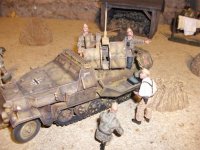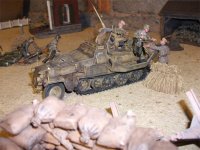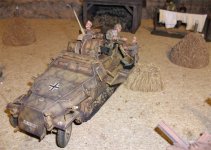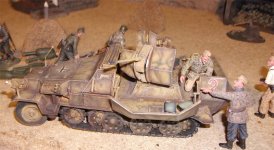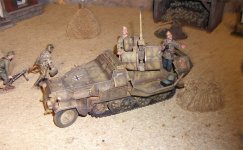redhugh
Master Sergeant
- Joined
- Oct 4, 2007
- Messages
- 1,348
The division was the creation of Reichsmarschall Hermann Göring and increased in size throughout the war from an Abteilung (battalion) to a Panzer corps.
One of the battalion formed from the flak units became the Fuhrer Flak Battalion. This battalion was first used as a special train escort on the Fuhrer's trip to Poland and as flak protection at his "Wolf's Lair" in E. Prussia. Later, it was organized into a regiment and eventually became the Fuhrer Escort Division.
At the outbreak of war the HG Regiment fought in Poland. Reorganized into the HG Division, they were sent to Italy for about one year. On 6 January, 1944, the division was renamed "Fallschirm Panzer Division Hermann Goring" that consisted of panzer, armored artillery and infantry battalions. They were sent back to Poland and fought in the battle of Warsaw in August 1944. During heavy fighting, the division, along with the Wiking, effectively destroyed the Red Army's 3rd Tank Corps. It was the greatest tank battle in Poland. Russians lost more than 500 tanks. They also served in Russia with the XXXIX Panzer Corps and at Fortress Graudenz in February 1945. By early May, the Panzerkorps was positioned near the Saxon capitol of Dresden. The remains of the corps began breakout attempts to the west, in order to surrender to the Americans who were currently halted on the Elbe. Despite valiant breakout attempts, the corps was encircled, and although several small groups successfully made it through to the west, the majority of the corps surrendered to the Soviets on 8 May 1945. As Luftwaffe men, along with the Waffen-SS and Polizei units, were seen by the Russians as war criminals, due to their involvement in atrocities committed on Eastern Front, the majority of the survivors of the Panzerkorps would not return from the Gulags of the Soviet Union.
One of the battalion formed from the flak units became the Fuhrer Flak Battalion. This battalion was first used as a special train escort on the Fuhrer's trip to Poland and as flak protection at his "Wolf's Lair" in E. Prussia. Later, it was organized into a regiment and eventually became the Fuhrer Escort Division.
At the outbreak of war the HG Regiment fought in Poland. Reorganized into the HG Division, they were sent to Italy for about one year. On 6 January, 1944, the division was renamed "Fallschirm Panzer Division Hermann Goring" that consisted of panzer, armored artillery and infantry battalions. They were sent back to Poland and fought in the battle of Warsaw in August 1944. During heavy fighting, the division, along with the Wiking, effectively destroyed the Red Army's 3rd Tank Corps. It was the greatest tank battle in Poland. Russians lost more than 500 tanks. They also served in Russia with the XXXIX Panzer Corps and at Fortress Graudenz in February 1945. By early May, the Panzerkorps was positioned near the Saxon capitol of Dresden. The remains of the corps began breakout attempts to the west, in order to surrender to the Americans who were currently halted on the Elbe. Despite valiant breakout attempts, the corps was encircled, and although several small groups successfully made it through to the west, the majority of the corps surrendered to the Soviets on 8 May 1945. As Luftwaffe men, along with the Waffen-SS and Polizei units, were seen by the Russians as war criminals, due to their involvement in atrocities committed on Eastern Front, the majority of the survivors of the Panzerkorps would not return from the Gulags of the Soviet Union.


